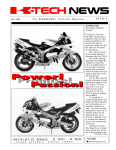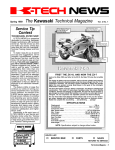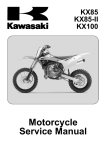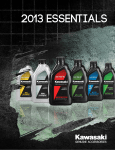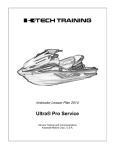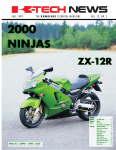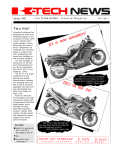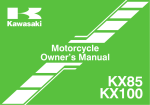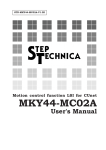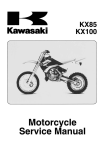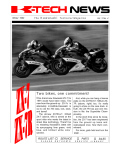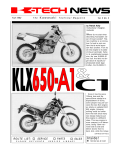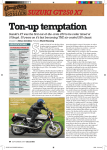Download K-Tech News Vol. 4 No. 4
Transcript
Winter 1991 The Kawasaki Technical Magazine Vol. 4 No. 4 by Patrick Kelly Instructional Designer/ Instructor With the introduction of not one but two new high performance watercraft for 1992, Kawasaki has given he competition a staggering one-two punch! And not only will the competition be amazed, but so will you the first time you take a spin on either the JS750A1 “750 SX,” or the JH750A1 “750 SS.” Never before has there been such high performance offered in a personal watercraft, and it took Kawasaki’s performance and engineering expertise to do it. Start with the engines... Although their respective hulls are unique, every discussion of these new watercraft begins with their engines. Both craft share the same in-line, twin-cylinder, 743cc twostroke engine. Even though the new 750 engine’s overall layout is similar to the 650 series of engines, it is completely new from the ground up. It boasts a 4mm larger bore (at 80mm) and a 6mm longer stroke (76mm) than the 650 engine. This new engine features an aluminum cylinder with cast-iron liners which extend below the cylinder base to reduce piston slap. The pistons are an aluminum silicon alloy with two steel ä ROUTE LIST: o SERVICE P L E A S ER E T U R N o TOS E R V I C E PARTS o SALES L I B R A R Y Inside! n Service tips & more! Easy maintenance pump 1-2-3 Punch CONTlNUED FROM PAGE 1 piston rings. The rings– upper ring a keystone type, lower a rectangular type– are plated with “quick break-in” chrome plating, porous coating which retains oil for optimum lubrication and low friction. The 750’s intake system consists of an intake silencer, Keihin CDK II 40mm carburetor, and two rankcase-mounted eightpetal reed valves. Lubricaon is handled by Superlube automatic oil injection. The 750’s exhaust gasses travel through a pre- muffler, then an expansion chamber, water box muffler, exhaust silencer (a first in Kawasaki watercraft history), and finally an exhaust outlet in the stern. The exhaust systems do vary slightly between the two craft, with the 750 SS featuring a “dry” type of expansion chamber, similar to the one used on the 650 TS and 650 SC. The “dry” exhaust increases the engine’s performance by waiting until after the expansion chamber to mix in the cooling water, allowing the expansion chamber to operate more efficiently. The wonderful new 750 engine is matched to an aII new jet pump. The new 750 jet pump is an axial flow single-stage pump similar in layout and size to the 650 series of pumps, having an impeller that is the same diameter, at 140mm. The impeller is aII new in design and features a varied pitch with a specially contoured trailingblade edge to help minimize cavitation erosion. The scoop section of the pump is now part of the hull, making pump sealing easier when removing and replacing the pump. The pump driveline also features a rubber damper to absorb shock loads and reduce driveline noise. What do all these powerplant and jet pump features add up to? Well, how about a whopping 63 hp and 551 Ibs of thrust on the 750 SX and an even more incredible 69 hp and 570 Ibs of thrust on the 750 SS! Impressive hulls Electronic ignition a first The biggest news about this new powerplant is the digital capacitive discharge ignition (CDI), used for the first time on any personal watercraft. Digital ignition uses a microprocessor and a predetermined timing data map to control the ignition timing very accurately throughout the rpm range, for optimum performance at all engine speeds. For example, the timing can be ideal for easy starting and also for maximum top 2 K-Tech News l end power. In addition, the digital ignition’s rev limiter is much more accurate, controlling engine rpm to 8000 ±100, while conventional analog ignitions are only accurate to ±250rpm. This new ignition works in conjunction with a water temperature sensor, located in the water bypass line, to limit engine rpm to 3500 anytime the cooling water temperature rises above 194° F. - Patrick Kelly The hulls on these new craft are as impressive as their powerplants. The 750 SX has been designed with the aggressive rider in mind. Its hull features a larger dead-rise angle as compared to our other stand-up watercraft. This combines excellent straight-line stability at the high speeds the boat is capable of with outstanding cornering ability. The 750 SX also has the proven self-righting and self-circling features as found on all of Kawasaki’s other fine stand-up craft. The 750 Super Sport also has a unique new hull design. It too features a large dead-rise angle for excellent straight-line stability. Special attention has been given to the SS’s cornering ability as well. It has been designed to keep its pump in the water and corner very predictably, without surprises. The 750 SS can also brag about such key items as an LED fuel gauge, as well as LED’s to warn of low oil level and overheating. You can’t fully appreciate all the great features of these magnificent watercraft by reading about them or looking at a few photographs. Just as nothing can fully describe the thrill of riding a ZX-11, words alone can’t fully describe the thrill of riding either of these new watercraft, except the feeling you’ll have the moment you push that throttle to the stop, and hang on! o New Parts Publications Specialist Technical Services is pleased to announce the addition of David Pyle as Parts Publications Specialist. His is the new voice you have heard if you’ve called the Micro-K department recently. David comes to us from earn Green where he has worked as a technician for the last five years. His responsibilities at Team Green included preparation of the KX500s which, ridden by Ted Hunnicutt and Larry Roeseler, have dominated the SCORE offroad racing series for the last three years. Before that, David worked for two years in the West Region parts distribution center. His technical background and energetic attention to detail are what make David especially qualified for this position. In both of David’s previous positions at KMC, he worked extensively with the Micro-K system and had lots of contact with dealership personnel. David says he enjoys that contact with the dealership people and looks for- ward to more of the same in his new job. He clearly understands how important Micro-K is to the dealership and already has some ideas about how to improve the usefulness and accuracy of this important tool. Dave’s only request: If you have any problem with a Kawasaki Micro-K product, please call him or send in a Micro-K Report Card. o Micro K-Tech Good news! No more hunting all over the shop for a back issue of K-Tech News, knowing that a) someone has it at home; b) someone has lost it; or c) someone has hidden it from you. All past issues of K-Tech are now on microfiche. Starting with this issue, you will receive “Micro KTech” on a regular basis with every Winter issue. This way you will always have easy access to all the information. An index at the top lists articles by subject rather than title so it’s easy to find exactly what you’re looking for. We hope that you will find this new addition to be a useful tool. o $100 reward! Parts department time saver Here at Kawasaki Technical Services, we have made a New Year’s resolution to get more tech tips from you “hands-on” people at the dealerships. To that end, beginning with the new year, we will send a $100 check to any Kawasaki Technician who submits a tip that we print in KTech News. Tips could include such things as creative diagnostic techniques, homemade special tools, time-saving ideas, quick solutions to common problems, etc. So send in your ideas. If we print it, we’ll send you a check for $100! Write to K-Tech News, c/o Tech Services Dept., Kawasaki Motors Corp., U.S.A. o by David Pyle Micro-K Specialist Here’s an idea to save your Parts Department and your customers time and avoid mistakes. How many times has a customer come into your store to order parts and given your parts person the wrong year or model information for his or her vehicle? For example: The customer has a KX500-E3 (‘91); he bought it in December 1990 and he remembers that year, not the model year. So you order a rear disc for him, which of course has holes (‘90 version) instead of slots (‘91). Most dealerships have experienced this kind of thing. So how can you avoid the cost in time involved in an RFC, not to mention having a dissatisfied customer? My suggestion is to have business cards handy with your store’s name, address and phone number printed on them— and space for your customer’s vehicle or hull I.D. number, engine number, and vehicle color. Fill out one of these cards every time you sell a new or used vehicle and give it to your customers. When they see that card in their wallet, they will remember your dealership. Also, leave some blanks at the parts counter for new customers. They will be less likely to remove this card from their wallet because it has important information about their own vehicle. o The Technical Magazine l 3 G U E S T S P O T Winter 1991 Vol. 4 No. 4 ©1991 Kawasaki Motors Corp., U.S.A. (KMC). All rights reserved. Kawasaki conquers Baja 1000—again! K-Tech News Staff by David Pyle Former Team Green Technician Publisher Kawasaki Tech Services The final results can be summed up by using the Publications Manager motto of one of the most respected men in motor Don Church sports today, Roger Penske: “Effort = Results.” Executive Editor Gary Herzog No statement could be closer to the truth when talking about Kawasaki’s Editor-in-Chief recent victory in the Baja Gregg Thompson Patrick Kelly 1000. For sure, I can’t think of another race in which Kawasaki competes Regional Editors that requires so much prerace preparation. Testing for this prestigNorth and East ious off-road event continFred DeHart ues pretty much all year round. Team Green uses Central and South both national “hare and Walter Rainwater hounds” and local district desert races as testing Contributors grounds for suspension, engines and pipes. A raDave Behlings, John Porno, dar gun and tach are used Joe Nowocinski, David Pyle, to determine a bike’s potential with different pipes, Steve Rice, Mary Sola, cylinders and gearing. Ray St. John, Bill Zito Because the Baja 1000 Graphics/Production is laid out differently each year, final settings must be chosen that will best Graphic Art match the course condiGregg Thompson tions. This year’s course was relatively fast; our Copy Editor race-winning KX500-E4 Pat Shibata was able to race across the dry lake beds and Production paved sections of the Nickless Communications course at just under 120 mph thanks to a 16/42 final drive. Published by Kawasaki. All In stock form the KX500 is an extremely capable suggestions become the property of KMC. Sending a machine, but to be competitive in an event as gruservice suggestion gives eling as the Baja 1000 Kawasaki permission to publish and/or use it without some changes are called for. An adjustable steering further consideration. damper is used to keep Specifications subject to the big KX “on the straight change without notice. 4 K-Tech News l and narrow” at extreme racing speeds. Dunlop 695 Desert “A.T.” rear and K139 front tires, designed to withstand the incredible heat and brutal impacts of the rocky Mexican desert, replace the OEM rubber. Water pump and ignition guards are added to the frame (similar to those on a KDX250), as are a welded-on skid pan and an aluminum rear disc guard. Even the handlebars get some special attention: First a Bar Snake™ is installed in the center; then molten lead is poured in the ends; and finally an aluminum plug is welded in the ends of the bar, drilled and tapped to accept Ninja 750 bar end weights. The result? Greatly reduced vibration and rider fatigue. The ignition is adapted from the Japanese version of the KDX250 “SR.” This ignition system produces enough wattage to power two 10-inch driving lights from just above idle, and can be varied from 100 to 200 watts. The lights are mounted in a lightweight frame that is rubber mounted on the triple clamps. Four quickrelease pins hold the assembly in place so that at sunset the lights can be installed on the bike in less than 10 seconds. CONTlNUED ON PAGE 11 ’91 service bulletin recap New A&P checklists! When you assemble a new motorcycle (or other Kawasaki product) and prepare it for customer delivery, you fill out the Assembly and Preparation (A&P) Checklist. This helps you remember those small but important items that can undermine a customer’s confidence in your store, and is a permanent record of your thoroughness. There were two different Kawasaki A&P checklists, one for vehicles and one for watercraft. Recently, however, we decided to make future checklists more product-specific, deleting many of the items that now must be crossed off because they do not apply to all products. A&P checklists are now available that cover motorcycles, ATVs and utility vehicles separately. Free to authorized Kawasaki dealers, the checklists come 25 to the package. You just received a service bulletin (SP91-01) with an initial supply of the new checklists for your use. But here’s the important part: All back orders on the old Kawasaki Vehicle Dealer’s A&P Checklist (P/N 99995590-07) are cancelled. Order what you need of the new checklists from your Kawasaki Parts Distribution Center: NEW A&P CHECKLIST PART NOS. Product line Checklist P/N Motorcycle ATV Utility Vehicle 99964-1053-01 99964-1052-01 99964-1051-01 Check this list against your service bulletin binder to see if you have everything the Service Training and Communications Department sent out during calendar year 1991. The dates given are for the latest revisions, if any. If you’re missing any of these and would like copies, give us a call at (714) 770-0400, Extension 2472. Motorcycle Service Bulletins Number MC91-01 MC91-02 MC91-03 Date 3/8/91 3/8/91 4/19/91 MC91-04 6/21/91 MC91-05 8/16/91 Title/Subject Motorcycle Chronology Table ATV Chronology Table KZ1000-P8/9/10 Transmission Bearing Recall ZX600-D2/L Camshaft Knocking Factory Authorized Repair Voyager Audio Repair Service Marine Product Service Bulletins Number MR91-01 Date 8/30/91 Title/Subject All JET MATE Maximum Capacities Label Replacement Racing Support Service Bulletins Number RS91-01 RS91-02 RS91-03 Date 1/18/91 4/12/91 4/12/91 Title/Subject KX80-R1/T1 Race Tuning KX125-H2 Race Tuning KX250-H2 Race Tuning Special Tool Service Bulletins Number SP91-01 SP91-02 Date 2/8/91 7/19/91 Title/Subject MULE 500 New Special Tools MULE 500 Special Tool Misassembled ® JET SKI Watercraft Service Bulletins Number JS91-01 JS91-02 Date Title/Subject 3/8/91 6/28/91 JS91-03 7/19/91 JS91-04 8/23/91 JS91-05 10/8/91 Watercraft Chronology Table JL650-A1/JF650-B3 Cooling System Blockage, Factory Directed Modification JF650-A6 Steering Shaft Breakage Recall JL650-A1 OilTank Blockage Factory Directed Modification JF650-B1/2 Fuel Filler and Gasket Recall Technical Training Service Bulletins Number TR91-01 TR91-02 TR91-03 TR91-04 Date Title/Subject 10/25/91 Technical Training Video Tapes Available 10/25/91 Technical Training Manuals Available 10/25/91 Technical Training Posters and Wall Charts Available 10/25/91 Special Service Publications Available KX125/250J Service Manual corrections! Make the following corrections in your copies of the KX125/250J Service Manual (P/N 99924-1153-01): That’s it. Aren’t you glad you saw this little gem of an article? - Ray St. John Page 4-16, bottom. The last photo on the page should show the rod being installed with the slotted end outward. The last sentence on the page should read: “Install the main valve rod (A) in the cylinder so that the slotted end (B) is on the outside.” (See i//us., right. -Ed.) Page 13-4, Specifications. The first sparkplug listed for the KX125-J1 should be NGK R6254K-105. The KX125-J1 sparkplug for (A), (C), (E) should be NGK R6252K-105 (resistor type). The Technical Magazine l 5 A plug (or two ) for the KX line ... by Gregg Thompson I f you’ve run into trouble lately trying to supply your 1992 KX125-J1 and KX250-J1 customers with spark plugs, this article is for you. While researching this article, I found six factory recommended plugs in the standard heat range for the 125 plus a couple more that can be used in a pinch. The standard plug for the US model KX125-J1 is the NGK R6254K-105. The Canadian resistor plug (R6252K-105) is virtually identical and can be interchanged. These are racing-type plugs with a special (short) ground electrode that is very resistant to breakage. The microfiche also lists the R4630A-105 which is the same as the R6254K105, but with a platinum center electrode. This plug costs a lot more and the only real advantage it offers is increased wear resistance. As another alternate for the R6254K-105, the R6254E-105 can be used. The only difference here is it comes with a 0.6mm gap instead of 0.8mm. Because of the short ground electrode on these racing plugs, the gap is not considered adjustable, but the 0.6mm gap will work. If you are looking for something a little more common, the microfiche also lists the B10EVX; the “X” at the end indicates a platinum center electrode. The B10EV is the same (fine wire) plug, but without the platinum. These are not “racing” type plugs and should be changed more often-the ground electrode can fatigue and break off under extreme conditions or extended use. Also listed on the microfiche are the ND W31ESZU and W31ESR-ZU, the Nippon Denso equivalent Warm ‘em up first by John Pomo Product Support Specialist R emoving brake discs from any of our KX models can be a little difficult because of the locking agent used at the factory on the mounting bolts. We have even heard of a few guys using a hammer and impact driver to get them loose -not a good idea! The small mounting flanges on the hub which these boIts thread into can be easily broken by using an impact driver. To remove these bolts (and any bolt secured by a locking agent), use a propane torch to heat the bolts first. Then, remove the bolts with a wrench while they are still hot. o 6 l K-Tech News of the standard NGK plugs. The story is a little different with the KX250. Other than the standard NGK R6254E-9, the microfiche lists only the resistor plug (R6252E-9) and the platinum plug (R4630A-9). This doesn’t give you a lot of alternatives if you can’t get the standard plug for some reason. The B9EVX is not listed because of a tendency to fatigue in this engine and lose its ground electrode. Because of this potential problem, you should stick with the racing-style plug whenever possible. But if you don’t have the racing plug (any port in a storm?), the B9EV or B9EVX will work. Just bear in mind that the ground electrode is a little fragile for this engine, so change the plug often. Most spark plugs can be ordered from Kawasaki using the spark plug number (i.e. R6254K-105) as the part number. o KX250-J1 piston news T he 1992 KX250-J1 piston has a hard ceramic composite coating around the bottom of the skirt designed to increase piston durability. Early production units have shown some unusual piston wear that has been traced to this hard coating. On later production units and all spare parts pistons, the ceramic coating has been modified and the bottom of the skirt is chamfered more. The modified pistons do not exhibit the same rapid wear. The wear that occurs on the earlier piston may be mistaken for damage resulting from a seizure. In extreme cases, it appears around the entire skirt and up the intake side of the piston. Although the wear can look pretty bad at times, it typically does not result in any performance loss or engine failure. You can reduce an early piston’s tendency to do this by increasing the chamfer at the bottom of the piston from 0.5mm to 2.0mm. The later pistons already have a 2.0mm chamfer. - Gregg Thompson You don’t have to bleed Have you ever had trouble bleeding the front brake on a late-model KX bike? You bleed it and bleed it, and just can’t get that firm lever you know it should have? The cause could be bubbles of air hiding out in the highest point of the hydraulic line. As you pump fluid through the system, you’re trying to force these bubbles down that long hose toward the caliper. But some of the bubbles may choose to obey other laws of physics and drift up hill, creating a three steps forward, two steps back situation. Why not get all the laws of physics on your side by bleeding that air bubble uphill. Take the master cylinder off the handlebar and hold it up with the hydraulic line straight and the ball end of the lever pointing up. Now push on the front caliper, forcing the piston all the way into the caliper body. This will force a large volume of fluid uphill into the reservoir. While holding the master cylinder high, pump the caliper back up, wait about a minute and then push the caliper in again. If the problem was air trapped in the line, this should take care of it. If this procedure doesn’t solve the problem, look for a misaligned caliper mount or a bent or cupped disc. - David Pyle A couple of quickies ... I t’s a fairly common practice for dealer mechanics to use grease as an anti-seize compound on spark plug threads. This is not a good idea because the grease acts as an insulator and can actually change the heat range of the plug. Anti-seize compounds specifically formulated for this application have metallic particles in them to improve their conductive properties. n Have you ever had trouble getting a woodruff key to stay in place while you put the flywheel on? Try putting a drop of super glue or even some heavy marine-type grease on it to hold it. Tip the leading edge of the key down slightly so its less likely to catch the edge of the keyway in the flywheel when you slide it on. As you tighten the flywheel on the taper, the super glue will break loose and allow the key to seat properly in the groove. - Steve Rice Gasoline: What you see is not always what you get! I t’s an unfortunate fact of life in the motorcycle fast lane that when your customers gas up their bikes, fuel is not always the only thing they’re putting into their tanks. Depending on the type and condition of the underground storage tanks at the gas stations, they can also be adding a variety of contaminants including water, rust, and dirt along with the gas. Kawasaki vehicles are equipped with a fine-mesh screen on the petcock to keep these contaminants out of the carburetors, but tiny particles and water still get through and can cause trouble in the carbs. Inspecting the carbs for these “bad news intruders” is a good procedure to include in a normal tune and service. Just drain the fuel from each carb bowl into a cup and inspect it. If it has anything in it, turn the fuel valve on (“pri”) and allow some fuel to run through the bowl, flushing out any other debris that is in there. This same procedure also works well for flushing any contaminants out of the float valve. When a carburetor has a problem overflowing fuel while the engine is running, it’s usually caused by debris caught in the valve. The debris doesn’t flow through the valve because the valve only opens a tiny bit to allow enough fuel flow to suply the engine. When the float bowl is drained, the float drops to the bottom allowing the valve to open wide. Then when you turn on the fuel, it will usually rinse the culprit right out. - Dave Behlings The Technical Magazine l 7 T I P S F R O M T H E S P E C I A L I S T S Police bikes: Making the most of chains and sprockets by Bill Zito National Police Motorcycle Coordinator P art of the curriculum in our Police Motorcycle Maintenance course is a discussion of proper drive chain maintenance and service life expectancy. The Kawasaki Police 1000 motorcycle comes equipped with a high quality endless “O” ring chain. Even when the Police 1000 motorcycle is subjected to rather severe enforcement usage, the OEM drive chain and sprockets should have a minimum service life of 15,000 to 20,000 miles— providing proper maintenance and adjustment procedures are observed. Because the lubricant for the pin and bushing is sealed in with “O” rings, the chain needs only light exterior lubrication. In fact, for long life it is just as important that the chain be kept clean. Dirt is very abrasive and will wear the chain and sprockets prematurely. As part of routine maintenance, the chain should be cleaned and lubed about every 200 miles. With the bike on its center stand, spin the rear wheel and spray a light coat of chain lube on both sides of the rollers. Then, with a clean towel, grasp the lower chain run and turn the rear wheel backwards to wipe off the dirt and excess lube. (Always turn the wheel backwards to avoid pulling your hand into the rear sprocket; never use the engine to rotate the chain while you clean it!) If the chain has a heavy dirt build up, it should be removed from the motorcycle for proper cleaning. After taking it off, clean it using a light lubricant like Kawasaki Multi-lube, WD40, or Bel Rey 6-in-1. Do not use cleaning solvents like those found in parts washers (which attack the “O” rings) or high pressure power washers. Use only soft bristle brushes (i.e. nylon or plastic), never metal wire type. After the chain has been cleaned, spray a light coat of chain lube over the rollers (both sides) and let it set while you clean the sprockets and the area around the engine sprocket. Another important part of chain maintenance is adjustment. This includes Proper chain tension and wheel alignment are key. TECHNICALITIES KZ1000P (Police) tune and service tip When doing a Tune and Service on a KZ1000P (Police) model, don’t forget to check the mechanical timing advancer. It must be lubed and operate freely. If this is overlooked and it becomes dry, it can stick and not operate smoothly. Also the springs can rust or get weak. When these conditions occur, the advance mechanism malfunctions resulting in poor throttle response and an unhappy motor officer. So help keep your customers happy by putting this little item on your Tune and Service list. - John Pomo 8 l K-Tech News providing the proper amount of chain slack and making sure the rear wheel is aligned properly. If the chain is too tight, not only will the chain and sprockets wear rapidly, but the transmission bearing on the output shaft behind the front sprocket will fail prematurely. The chain requires 1.2 to 1.6 inches of slack measured at the middle of the bottom chain run with the bike on the center stand. With less slack than this, the chain will be pulled tighter than a bow string at some point in the suspension travel putting enormous pressures on the final drive components. The specified chain slack may seem excessive to you, but it is correct and very important for long chain and sprocket life. o “Quick, Jack, quick jack!” Look-alike filters Most Kawasaki spin-on type oil filters look virtually identical on the outside. They will physically interchange from one model to another. From time to time the Hot Line gets calls from dealers wondering if they can stock just one of these seemingly interchangeable filters and sell it for all models it will fit. In a word: no! While they may look the same, all of these filters are different internally and have different flow rates. As a rule, it is not a good idea to interchange these filters unless your K-Share terminal or parts price guide says to. - Gregg Thompson Have you ever found yourself looking for an easy way to jack up a fourwheeler or a bike without a center stand to work on the suspension or change a tire? Well, Kawasaki has a great solution: The heavy duty “Dual Scissor” jack is solid, stable and easy to use. You won’t believe how popular this tool will become in your shop. A set of short adapters (for low vehicles like the VN1500 Vulcan) is available under a separate part number. Order today! - Joe Nowocinski Dual Scissor Jack: Short Adapters: P/N 57001-1238 P/N 57001-1252 Double duty tool siphons gas or water 200 mph repair man Congratulations once again to Hot Line staff member Steve Rice for winning his second straight Dragbike U.S.A. OHC Funny Bike championship. Steve clinched the title by taking the overall win at the last meet of the year in Gainesville, Fla. On his way to winning the ’91 championship, Steve eclipsed the 181 mph Funny bike record he set last year, nailing down a new record of 7.088 sec. at 192 mph! Steve’s bike has a turbocharged, fuel-injected, alcohol-burning 1260cc KZ1000-P10 based engine housed in a handbuilt frame with an 80 in. wheelbase and 10-inchwide Goodyear Racing slick. It’s potential? On other occasions during the year, Steve was clocked at over 200 mph. . . Steve says that one of the most enjoyable parts of going to races all over the country (35,000 miles this year) is meeting inperson some of the Kawasaki mechanics he talks to on the Hot Line. What about setting all these records and winning back-to-back championships? “I’m just a motorcycle repair man,” he says. “Please don’t tell my mom!” Yeah, right Steve. Well, next year, be on the lookout for one quick motorcycle repair man at a drag strip near you. o Remember the article in the Summer ’91 issue of K-Tech News entitled “Coolant Pump Special Tool”? Well, the same homemade tool also works just swell for siphoning water out of the bottom-of a JET SKl® watercraft before working on it. And, siphoning is a lot easier than turning the boat over to drain it. As Hot Line Technician Ken Osberg explained, the primer pump and hoses come from the Tan- dem Sport (TS). To save you the trouble of looking up part numbers, here they are again: Primer Pump Hoses (qty. 2) 49043-3702 92190-3715 - Joe Nowocinski Kawasaki’s 192mph Hot Line staffer Rice on his “other line . ” The Technical Magazine l 9 High mileage mirrors H igh mileage ZG1200 Voyager VII’s can develop a minor but irritating problem with the mirrors. The mirror adjustment joint becomes looser as it wears and can get to where it will move out of adjustment from the wind at high speeds or when the vehicle goes over a sharp bump. The real problem occurs when the customer finds out this joint cannot be tightened and the mirrors must be replaced at a cost of over $35.00 each. If you have a customer who really objects to buying new mirrors, there is a way to modify his so the pivot joint can be tightened. The modification changes the appearance of the 10 l K-Tech News mirror slightly so let the customer decide whether to do this or replace them. To get at the joint, use a hole saw to drill a 1-inch hole in the back of the mirror body. This gives you access to the adjusting nut, which you can then reach and tighten with a 10mm swivel socket. After the nut is tight, use a cap (Part Number 11012-1751-62) to plug the hole. - Bob Ellison Sport Cruiser: those dread decals! by Gregg Thompson Senior Product Support Specialist T he Kawasaki Hot Line Staff has received several calls lately about decals n JL650-A1’s peeling up round the edges. If you run into one of these, try to find the Fall 1990 issue of K-Tech News. On page 8 is a long article about decal R&R that should be of some help to you. That particular article emphasizes trying to get most of the adhesive off with the decal. And for our other watercraft, the methods described work well. Unfortunately, the deals on the Sport Cruiser are another story: If these decals are exactly the right temperature, you may get 50 percent or lore of the adhesive off with the decal. Note: The previous article emphasizes that pulling the decal straight up at a 90° angle to the surface is best for pulling up the adhesive with the decal. The “SC” decals seem to take more adhesive with them when pulled back across the surface. If they are not exactly the right temperature, nearly all the adhesive will stay on the boat. And even if 50 percent of the adhesive comes off, removing the other 50 percent can still be a big job. To remove the adhesive, soak some shop or paper towels in 3M No. 08984 adhesive cleaner and lay the wet towels over the adhesive. Paper towels work well because they don’t absorb so much of the cleaner but still do a good job of keeping the adhesive wet. Make sure the wet towel is making contact with the adhesive completely for 5-10 minutes. Then, remove the towels and scrape the adhesive with a plastic spatula while it is still wet. Most of the adhesive should scrape off. What is left will clean off with the adhesive cleaner and a coarse terry cloth towel fairly easily. Adhesive removers such as the 3M product referenced above (No. 08984) can be purchased at your local automotive paint store and also many auto parts stores. o Baja 1000 Part 4: Did you know. . ? CONTlNUED FROM PAGE 4 Other “high-tech systems” include a NASCARstyle quick-fuel setup; and a modified swingarm with chamfered wheel spacers and brake pads to speed up rear wheel changes. With an air wrench on the axle and nine carefully placed, well-rehearsed pit crew members, the end result is a refuel, rider change and rear wheel change in under 20 seconds, from engine stop to engine start. This year’s winning bike made four rear-wheel changes, all for fresh tires. But even meticulous preparation, the fastest bike, the best planning and the quickest pit crews can’t guarantee race wins. Having riders like eighttime Baja 1000 winner Larry Roeseler, four-time winner Ted Hunnicutt Jr., and motocross champ Marty Smith helps your chances considerably. Talented, yes, but it was this trio’s dedication to training and pre-running that really set them apart. The 1991 Baja 1000 boasted an incredible 42 Kawasaki entries! That’s up 50 percent from 28 in ’90. The riders did their part, the pit crews did their job, and the end result was First Overall Vehicle, plus 500cc, 125cc and Class 50 wins! The Kawasaki crew puts forth a more intense and dedicated effort than the rest of the competitors combined. The results? Four consecutive Baja 1000 overall wins! I guess Roger Penske has a point. o by Mary Sola Consumer Services Assistant Manager Now that the summer is over and the pace is a little less hectic, we can resume our “how-to” series on providing outstanding customer service. In previous issues (see K-Tech News Vol. 3 No. 4 and Vol 4. Nos. 1 and 2 -Ed.), we’ve talked about attitude and have outlined some steps you can take to keep customers coming back to your store as well as pointing out the types of behavior that drive them away. So, you have the right attitude and really want to make your store known for its excellent customer service. What now? Work on your communication! Good communication with your customers is a must. First, become aware of how you are communicating. Did you know that over 80 percent of what CONTlNUED FROM PAGE 12 The biggest news out here in the west region, though, is our newly refurbished and re-equipped training shop. We have spent some needed time and money on updating our tools and equipment to make your training experience more rewarding. So, if you haven’t visited us in a while, come on back and see us. If you have never visited us, you we communicate is nonverbal? It’s how you say what you say that’s most important. Pay particular attention to your body language and the tone of your voice when talking to customers, both in person and over the phone. Secondly, really listen to n “Over 80 percent of what we communicate is nonverbal” n what your customers are telling you, don’t just wait for your turn to talk. Active listening is probably the cornerstone of good communication as it shows respect and interest. Few of us can resist feeling good about someone who’s in- have no more excuses. I’ll look forward to seeing you real soon. o CONTlNUED FROM PAGE 12 and some new techniques we can’t wait to pass along to you. Come take a class or three in this new year! Meanwhile, to all competitors, promoters, dealers, race fans and heavily addicted Xmas shoppers: I hope your new year will be enjoyable and successful! o terested in what we have to say and who treats us with respect. Some other tips: 1. Non-verbal contact. Nod, make eye contact. Have your posture show interest. Don’t try to do two things at once when a customer is talking to you, particularly an angry one. 2. Make noises–“yes,” “I see,” etc. Most of us think the other person isn’t listening if we don’t get some feedback. 3. Ask open-ended questions. Asking questions that give customers a chance to explain also gives them a chance to finish with their anger and get ready to move to resolving the problem. 4. Restate. Rephrasing what customers say in your own words shows that you understand what their concerns are and that you sympathize with the feelings they’ve expressed. o CONTlNUED FROM PAGE 12 Grand Rapids, January 29 and 30, 1992, at the regional offices. This will be the only Team Green class scheduled during the 19911992 training season. Jeff Chambers of Team Green will do his usual thorough job of updating your technicians on the 1992 product. Don’t miss this opportunity! Have a great new year as we start the next 25 years with Kawasaki. o The Technical Magazine l 11 R E G I O N A L N E W S Training Schedule East Region February 4-6 10-12 13-14 19-20 21 25-27 28 JET SKI® Watercraft Engines Fuel Systems Servicing the MULE 1000/2000 Servicing the MULE 500 Troubleshooting Elec. Systems Service Department Operations (K-BOSS) North Region February No classes scheduled Central Region February WEST SOUTH & CENTRAL NORTH & EAST New and much improved Happy new (leap) year! Before you reach “critical” by Patrick Kelly by Walter Rainwater by Fred DeHart 9950 Jeronimo Road Irvine, CA 92718 (714) 770-0400 6110 Boat Rock Blvd. S.W. Atlanta, GA 30378 (404) 349-2000 201 Circle Drive N., #107 Piscataway, NJ 08854 (201) 469-1221 Hey, it’s time for a West Region update already? Well, out here in Irvine, Calif., we (the Service Training and Communications department) have been very busy working on various projects (including K-Tech News, of course!) to keep you informed, up to date, and on the right track. For example, the new parts department video has been wrapped up and work has begun on the workbook which will be used in conjunction with the video. The Flat Rate microfiche is being updated to include the ’92 models and eliminate discrepancies among similar models. We have also been busy revising the Electrical Troubleshooting Guide, Police Motorcycle Maintenance Manual and the Team Green student text. It’s hard to believe it but a new (leap) year is upon us already. There are many tell-tale signs-hordes of berserk shoppers swarming the malls here in Atlanta in search of afterChristmas bargains to name just one! We in the motorcycle industry have seen the telltale signs as well. Sadly, all the major motorcycle racing series-off-road, motocross, supercross, hare scrambles, drag and road racing, and all the rest of them- are over. (Happily, Daytona is just one month away as I write this!) What the coming of a new year means to us here in this office, of course, is another round of training classes. We’re working flat out to stay on top of all the model changes Lately all my phone conversations have been problems that have escalated to “critical mass” crisis time. If your dealership has a technical problem, parts problem, or just a question, please call before frustration sets in! The Product Support Hot Line is a toll-free number. Use it! And feel free to call the regional off ice anytime; I will gladly try to answer your questions, complicated or otherwise. No one has all the answers, of course, but we can’t solve a problem if we don’t hear about it. And if we don’t have the answer, chances are we can direct you to someone who does. North Region dealers please note: There will be a Team Green Race Preparation class held in CONTlNUED ON PAGE 11 CONTlNUED ON PAGE 11 CONTlNUED ON PAGE 11 12 l K-Tech News No classes scheduled South Region February MULE Dealer Orientation Servicing the MULE 1000/2000 Servicing the MULE 500 ATV Service Service Department Operations (K-BOSS) 18-20 Troubleshooting Elec. Systems 24-26 JET SKI® Watercrafl 3 4-5 6 10-11 12 West Region February 10-12 13 19-21 24-26 27 Police Motorcycle Maintenance Service Dept. Operations (K-BOSS) Troubleshooting Elec. Systems JET SKI® Watercraft 750 JET SKI® Update













